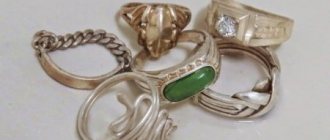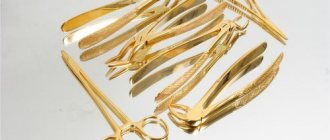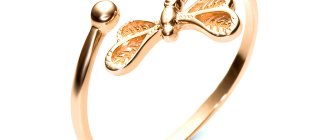General information
The appearance of blue gold products dates back thousands of years. The first craftsmen to learn how to produce metal were the Scythians. Some jewelry created by craftsmen from a traditional alloy with a sky-colored finish can still be found today.
Due to the high historical value, no one dares to conduct chemical experiments with ancient exhibits. Therefore, the secret of creating blue metal is shrouded in mystery and so far no one has figured out the full list of its components. However, there is information about the process of creating the blue alloy, which was practiced by ancient alchemists. According to them, to obtain an unusual material, you just need to combine iron and gold in a ratio of 1:3. For example, 25% of ordinary raw materials and 75% of pure precious metal are taken.
A similar method was used back in the 17th century, and three centuries later, the famous jeweler Antoniassi from Argentina discovered a way to produce an alloy containing 90% pure gold. The heavenly shade was achieved by adding cobalt in very small quantities. After a successful experiment, the jeweler was forced to disclose the entire list of components used, but he hid the technology for connecting them to each other. Jewelers still cannot obtain blue gold according to Antoniassi’s recipe.
Blue gold – an alloy of 18-carat precious metal and iron
What does blue gold represent for modern masters? This is an alloy of 750 precious metal and iron. Despite the presence of noble raw materials in it, it has more steel qualities than gold ones. If products made from such material are not properly cared for, they will irrevocably lose their aesthetic properties.
The main use of blue gold is jewelry. It makes unique jewelry such as rings, pendants, earrings, etc. Metal of unusual color can also be found in wristwatches. Most often it is used to create a body, followed by varnishing. Varnishing with a special composition helps protect the surface from mechanical damage and makes caring for products less troublesome.
What determines the color of the metal?
The emergence of colored varieties of gold is due to the impossibility of using this metal in its pure form to create jewelry. As you know, pure gold is soft, as a result of which this material can only be used in jewelry in the form of an alloy.

It was the addition of various chemical elements to the composition in order to strengthen the metal that had a key impact not only on the physical properties of the material, but also on its color. Combining gold with additional “strengtheners,” jewelers were surprised to discover that the impurities seemed to tint the metal, and the resulting substance was no longer yellow.
This unexpected discovery gave the world many different color variations of gold and actually gave jewelry makers complete freedom of creativity - now they could create gold items of almost any shade. To simultaneously strengthen and paint in various colors, the noble metal is still combined with the following elements:

- aluminum,
- nickel,
- palladium,
- rubidium,
- chrome and others.
Today, the jewelry market offers gold products in a variety of colors. In addition to blue and cyan, unusual (that is, non-standard) shades that are in great demand include:
- white,
- green,
- red,
- violet,
- black.
The creation of blue and cyan gold is the most secret process. The technology and nuances of obtaining metal of these particular shades are carefully hidden by manufacturers and are therefore only partially known.
Sample and composition of blue gold
Blue alloys are based on 585 or 750 gold. You can get them in several ways:
- a combination of gold and steel in a ratio of 2:1 or 3:1. Sometimes the composition includes chromium and other alloys. After this, the material acquires the properties of not rusting, but at the same time it is quite difficult to process it;
- the connection with indium makes the alloy from gray-blue to rich and blue;
- when combined with gallium, a pale blue tint is obtained.
Rhodium plating also gives gold its heavenly color. The process involves electroplating a thin film of rhodium onto the surface of the product. This allows you to enhance the shine of your jewelry and protect it from damage and chemical influences.
Blue gold composition
To give gold a blue color, indium is added to it. As a result of this connection, a metal is formed that is quite corrosion-unstable. And it is rarely used as the main component of jewelry; it is more often used as decoration for jewelry.
Another chemical element that can color natural gold blue is rhodium. The famous Argentinean jeweler Antoniassi was able to develop the alloy recipe in such a way that the fineness of blue gold is almost 958 (pure gold makes up 90% of the total volume). But the blue gold recipe is kept in the strictest confidence. The only thing we were able to learn from the Argentinean master is that the addition of small doses of cobalt gives the precious metal a delicate blue glow.
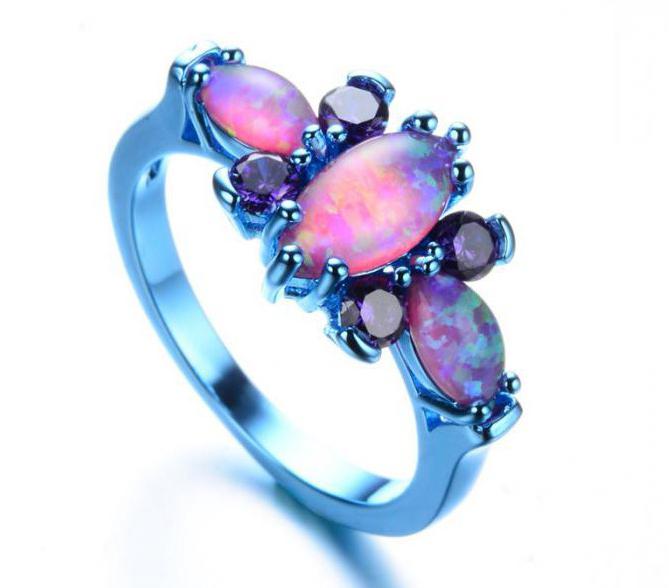
Properties and Features
The process of synthesizing metals to produce a precious alloy of unusual color is quite labor-intensive. Parts made from blue raw materials are attached to the main surface by soldering. A distinctive feature of the alloy is its fragility, which is also reflected in jewelry made from it. That is why they must be treated very carefully.
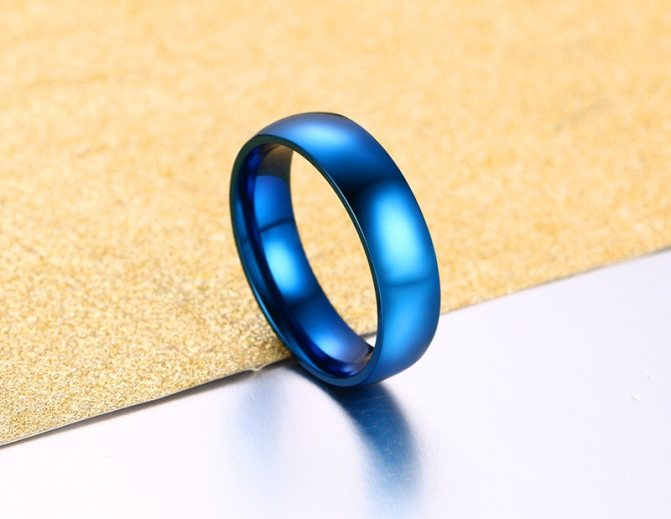
What does blue gold look like?
Alloys with the addition of third-party components, which give gold a sky blue or blue color, are not ductile; the material cannot be drawn into threads and forged, giving it the desired shape. This significantly limits its use and makes it impossible to create elaborately shaped products with many decorative elements.
Jewelers prefer to use the blue shade of gold as interesting inserts and elements in products. For example, earrings with a yellow gold frame and a colored center look beautiful.
Blue metal
But with this alloy everything is much simpler. Some craftsmen make it from natural gold with the addition of chromium and iron. The resulting alloy is quite fragile, and it will also not be possible to make a complete product from it. It is used only as one of the decorative elements. To impart blueness and strength to a precious metal, its composition must be as follows:
- the main component is pure gold;
- 22% steel;
- 25% expensive rare earth metals (including 2.5% platinum and 0.5% iridium).
This composition will allow the precious metal to carry a hallmark with the designation 750.
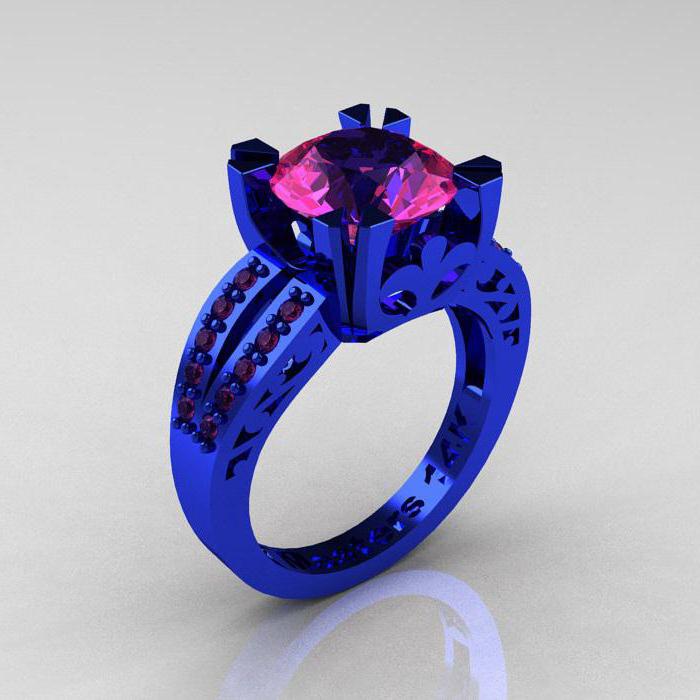
There is another way to get rich blue gold color. It is necessary to combine yellow gold (46%) and indium (54%). Then the blue gold will have a grayish tint. And if gallium is used as an additive, the shade will be light, more blue than blue. The sample will be assigned 585.
Such an alloy is an expensive and fragile metal, so only elite workshops can produce jewelry from it and use blue gold as decoration due to its physical and technical characteristics.
Modern methods of obtaining
With the development of modern technology, it has become possible to produce blue gold in large quantities. At the same time, its noble qualities are preserved. Each manufacturing company has its own secrets and methods for creating raw materials, which are kept secret from outsiders. Although it is worth noting that the International Association of Jewelers has established a rule according to which any innovation in the method of obtaining metal should be revealed to colleagues. However, not all companies comply with these requirements. In most cases, some general principles for performing work are disclosed.
To create colored gold, the material goes through a stage of exposure to high temperatures under high pressure. Shades are obtained using one of two methods:
- fusion;
- coating application.
The first method is considered the most reliable and strong. It is based on a chemical compound, which makes it the most effective. The resulting products are not only complete, but also durable.
First experiments
The first products made of heavenly gold were created thousands of years ago. The craftsmen who unraveled the secret of obtaining metal of this shade were the Scythians. Some jewelry created by Scythian craftsmen from traditional yellow gold and decorated with unusual blue inserts has survived to the present day. But, alas, it will not be possible to find out the composition of the alloy created by the Scythians - due to the enormous historical value that these products have, it is prohibited to conduct chemical experiments and analyzes with them.
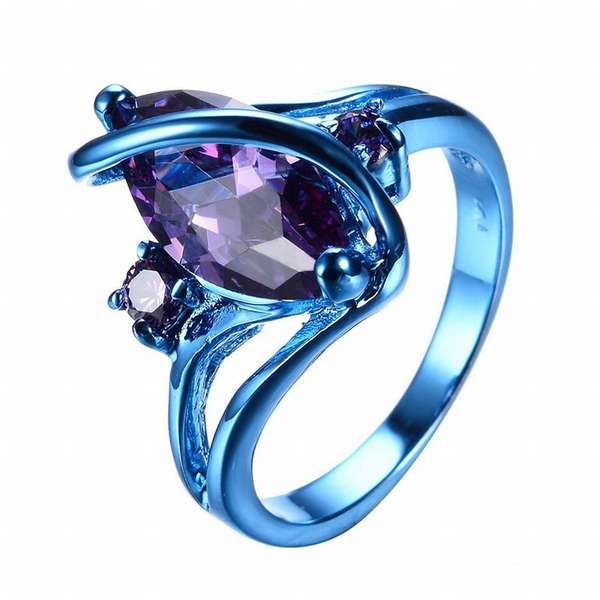
Ancient way

Surviving manuscripts have revealed a description of the process by which the first blue gold was obtained. Ancient alchemists claimed that to create such an alloy, you just need to combine iron and gold in a ratio of one to three, respectively.
That is, the oldest composition of blue gold:
- 25% iron,
- 75% pure gold.
Current results
The ancient experience has been repeated in modern times. But the results were disappointing. The alloy of gold and iron in the specified ratio had a silvery tint. A product made from this material first acquired a bluish color due to the oxide film formed on the iron. But soon the film turned into rust. The noble metal was unrecognizable, and the appearance of the jewelry was truly terrifying.
Shade options
The gold alloy of unconventional color has several shades. It can be either light blue or dark, rich blue, like a twilight sky. The variety of colors directly depends on the amount of a third-party component added to the gold.
It is generally accepted that blue and blue gold are one alloy with additional elements. However, this is not quite true. They have different composition. To create a palette of shades, various ligatures are used. Accordingly, the final result will differ. However, combining all the resulting alloys into one subspecies of the color category or dividing them into independent representatives is an entirely subjective choice.
The use of blue gold in jewelry
The narrow functionality of blue metal narrows the range of products made from it. Most often, cases and bracelets of wristwatches and inlaid items are made from such gold, stringing the parts onto wire and using them in combination with parts made of precious metal of other shades: pink, yellow, red and white.
Blue gold jewelry was known in Russia in the 17th and 18th centuries and has not yet lost its value. They can often be found in jewelry and designer collections.
Care and storage
The procedure for storing and caring for jewelry made of colored gold is practically no different from caring for ordinary products. Just remember that the blue top layer on the surface can be damaged due to careless handling.
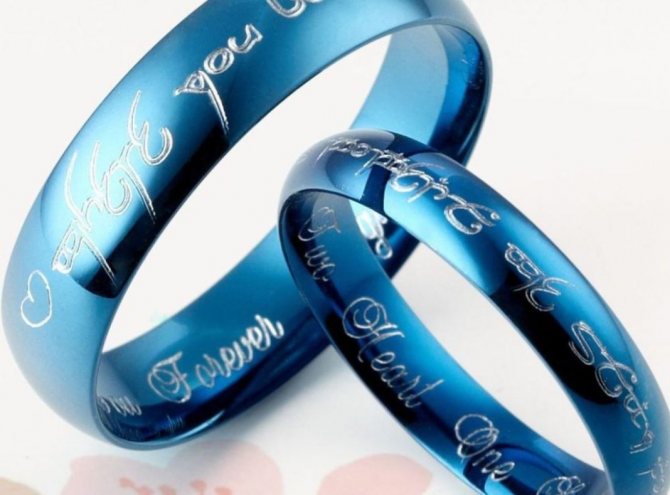
Storing blue gold is practically no different from caring for conventional products.
It is better to store blue jewelry separately from other things and especially stones. Any contamination is removed with a soap solution. After water procedures, the products are wiped dry and placed in the designated place.
How to spot a fake
When buying products made of blue, at first glance, gold, you may not get what you paid for. Not very honest sellers can pass off a cheap fake made of an alloy with steel or a rhodium-plated product as an expensive item. You can check the authenticity of your purchase using the following criteria:
- try. It should be smooth with the corresponding digital and letter designation;
- the manufacturer's trademark must be present on the inside of the product or fastener;
- magnetic properties of decoration. If the composition contains iron or steel, then the product will cost less than its analogue with the addition of gallium or indium.
It is not recommended to use traditional testing methods for colored jewelry.
They are not always effective. Also, do not drip vinegar or iodine onto the metal, because... The rhodium-plated surface is resistant to acids and will not show what is hidden under the top layer. The only accurate way to determine the quality of an alloy is with an electronic detector, which evaluates its electrical conductivity. If it is not possible to apply it in practice, and the seller seems suspicious, then it is better not to risk it.



